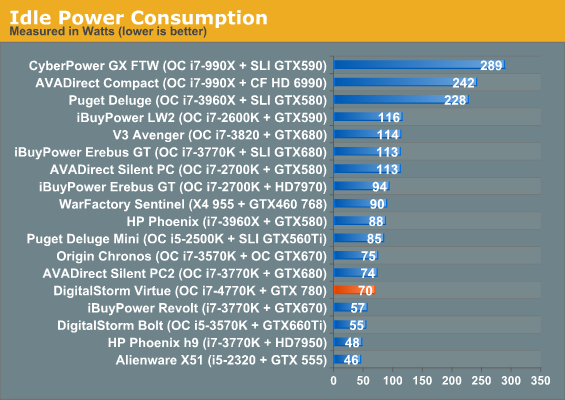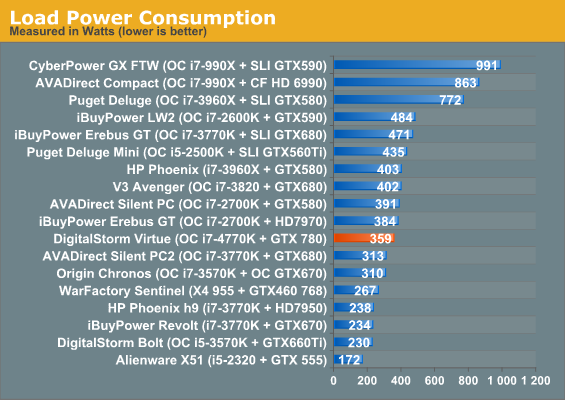Haswell and GK110 vs. Ivy and GK104: DigitalStorm Virtue System Review
by Dustin Sklavos on June 23, 2013 12:00 PM ESTBuild Quality
It's not entirely fair to DigitalStorm not to mention the generally excellent job they've done with the build quality of the Virtue. One of the ways a boutique can distinguish itself is in its component selection, and the stock component choices of the Virtue line are solid across the board.
Starting with the chassis selection, I'm actually a pretty big fan of the Corsair Obsidian 350D and I'm happy to see it being employed in a high performance system. Interestingly, DigitalStorm is also using Corsair's H100i to cool the CPU, but they're not employing Corsair Link software to control fan speed despite the system being wired to use it. Instead, the fans on the H100i (oriented beneath the radiator to pull in air from the top of the enclosure and then cycle it out of the rear exhaust) run at a fixed fan speed. I personally find variable fan speed to be distracting; I'd just as soon the whole system run silent all the time, end of discussion. DigitalStorm's choice here works for me.
.jpg)
The 350D also does an excellent job of showing off NVIDIA's reference cooler for the GeForce GTX 780, complete with the subtly glowing "GeForce GTX" logo. That's plugged into an ASUS Z87 Gryphon motherboard, and the system drive is a healthy 120GB Corsair Neutron GTX featuring an LAMD controller. Given all the Corsair kit in the Virtue, though, I'm actually surprised the memory is A-Data.
Where I'd be tempted to shake down DigitalStorm is in using a single stable voltage for overclocking the i7-4770K, but without more experience with Haswell and the quirks of its VRM I can't say if that's worth caring about or not. With the first generation chips (Nehalem, Clarksfield, Gulftown), this was a huge issue, but Sandy and Ivy were less problematic and it looks like Haswell is even less so. I do want to point out that DigitalStorm has traditionally been more aggressive about their CPU voltages than I'd like, but the i7-4770K's 1.28V is actually pretty common and totally reasonable.
Noise and Heat
Demonstrating a healthy amount of balance in their design, the Virtue isn't especially silent but is generally a touch quieter than enthusiast gaming desktops tend to be. Idle noise is around ~33dB, and since the CPU and chassis fans run at a fixed speed, the GeForce GTX 780 is really the only component that spins up or down. Unfortunately, while the 350D is an excellent case for liquid cooling, it does suffer slightly from Corsair's perpetual issues with middling air cooling performance.

Thermals on the GTX 780 are pretty par for the course, but it can jack noise levels up a couple of dB under sustained load. Meanwhile, the i7-4770K is really about where it needs to be. A more adventurous user might be able to eke a little more performance out of it with a little more juice, but I'd hesitate to push the H100i that much harder, especially without bumping the fan speeds up to a potentially uncomfortable volume.
Power Consumption
So how much power does a modern high end gaming system pull from the wall? The last couple of generations from Intel, NVIDIA, and AMD (Bulldozer/Piledriver notwithstanding) have all done an admirable job of continually reducing idle and load power consumption alike, so the DigitalStorm Virtue stands to benefit from those advances.


And it does. While neither one is abnormally spectacular, they're both totally reasonable. I'm not convinced DigitalStorm couldn't shave 10W or so off the idle power, but load power is where it ought to be.


_thumb.jpg)
_thumb.jpg)
_thumb.jpg)
_thumb.jpg)
_thumb.jpg)
_thumb.jpg)








70 Comments
View All Comments
wumpus - Monday, June 24, 2013 - link
Airflow. 800W of airflow.[Actually this ends up being heat in the ambient room to, just not always in the case. No matter what work you do, adding 800W into a area means 800W of heat: EM waves just makes the area bigger :)].
iamezza - Monday, June 24, 2013 - link
Actually all the power consumed will eventually end up back as heat. It's how physics works.MrSpadge - Monday, June 24, 2013 - link
Ouch.. someone's about to enter the shame corner of our little physics class!jameskatt - Sunday, June 23, 2013 - link
We long ago hit the wall on how fast on overclocked CPU can perform without burning out or using liquid cooling systems - the soaking the entire computer in mineral oil. It is simply the laws of physics that present a wall that CPUs cannot bridge.It is not surprising that Haswell hit that wall.
You can give GPUs more bandwidth and more cores to get faster and faster speeds. They key is that GPUs have massive numbers of cores and GPUs are used for massively parallel tasks.
The key to future performance is parallelism - the more cores in a CPU the better.
In day to day use, I have more than 20 apps running at the same time - at least I would like to. But I am limited by the number of cores my computer has. Four cores is simply not enough.
For example, Parallels and Jabber Video each require 1.5 cores each. When I have them on simultaneously everything else grinds to a halt since every other app has only one core left for it.
It would be nice to have 12 cores per CPU when doing a lot of multitasking.
The future is multiple cores - more than 4. The more cores the better.
It doesn't do good to complain about the limits of 4 core CPUs. They simply cannot do any better without specialized liquid cooling or other weirdness.
lmcd - Sunday, June 23, 2013 - link
You've clearly missed the complaint, which is that the die package used to be connected with what's called here a "fluxless solder," which has high thermal conductivity and transfers heat well to the metal surface that you see on production chips (I forget the name for that layer). That metal surface is then cooled with your heatsink, etc.The problem is that the fluxless solder was replaced with a thermal paste to save an incremental amount of money. The thermal paste is unable to transfer the same amount of heat per time. This means that no matter how good your cooler is, even if you're dissipating heat very quickly from the surface I mentioned, there is more heat retained inside the chip between the surface and the package.
So it's a valid complaint. And Haswell didn't hit a wall, its solder hit a price wall.
Nottheface - Monday, June 24, 2013 - link
So by what you have said above anyone who takes off the IHS and removes the "bad" paste should have great overclocking ability compared to leaving on the IHS with the paste. This is not true and means that isn't truly the base problem. Like Ivy Bridge delidding reduces the temperature of the chip greatly ~30°C, but only marginally increases overclocking.It has also been shown with Ivy Bridge that it isn't the paste so much as the spacing between the chip and the IHS that causes the bad heat transfer. The paste doesn't help, but for better heat transfer you are always better off removing extra interfaces and distance the heat has to travel.
MrSpadge - Monday, June 24, 2013 - link
I've heard that the 22 nm transistors couldn't take the temperatures the soldering produces. No hard proof, though.lmcd - Sunday, June 23, 2013 - link
Furthermore your "parallelism" is too all-powerful. If those wonderful GPU "cores" (hint, they're not cores; they're clusters) were given the same cooling mechanisms as these CPU cores, your computer would be up in flames or your magic "parallelism" would be running at 1/2 speed.Yes, multithreaded applications are great. Yes, more cores is great. But cooling the existing cores properly and running them at the frequencies they *should* be able to hit is still a valid solution, and in most applications there is the headroom to do so, should that fluxless solder be reintroduced into Intel's CPU packages.
And besides, if you're running parallels and jabber video, get yourself a Sandy-E. You're a niche, so buy the niche product that fits your needs. My 3960X meets my multicore needs, and you can even settle for a 3930K if you're not concerned about clockspeed.
wumpus - Monday, June 24, 2013 - link
The reason GPUs aren't on fire isn't so much superior cooling (you try cramming a CPU heatsink into a single or even double slot), so much as cores designed for high efficiency at the cost of painful latency. Trying to use one of those "cores" would be like going back to the PC-AT days (with the exception of floating point single performance, more like the DSPs of those days). Larrabee was a bit more CPUish (and thus would have melted down if they ever got performance anywhere near competitive) but would still be outperformed at traditional CPU (serial) tasks by an atom.Sabresiberian - Sunday, June 23, 2013 - link
The future is multiple cores, I think we are just beginning there, but you are wrong about the clock limit, and certainly AMD has proven that by releasing 5GHz factory CPUs. And, if the chips can be OC'd in extreme builds to 8GHz or better, then I suggest it IS feasible to eventually get that kind of clock in a production chip.If Intel wanted to, they could make production CPUs run at 5GHz base with a turbo to 5.8 easily enough. We could be OCing those to the 6GHz range. On air, or an AIO water cooler, no liquid nitrogen required. They just aren't putting their efforts in that direction.
3.6GHz is conservative.